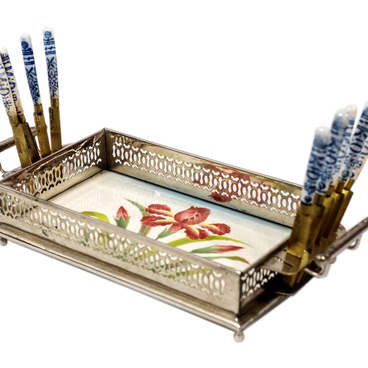The main type of women’s clothing in the Middle Urals was a set with a dress of the Northern Russian type. In the early 19th century, it was worn by the wives and daughters of merchants and traders, factory employees, and peasants.
Children's dress
Creation period
Dress: early 20th century; shirt: late 19th — early 20th century; belt: 1900–1905
Dimensions
Dress: length 89 cm, hem width: 90 cm. Shirt: length: 46.5 cm, sleeve length: 54 cm. Belt: length: 145 cm, length with tassels: 158 cm.
Technique
hand sewing, machine sewing. Shirt: hand sewing, industrial lace. Belt: weaving.
Collection
5
Open in app#1
Oblique-cut children’s dress with a shirt and a belt
#3
#11
Wearing oblique-cut dresses was a notable fad. Those consisted of two straight cloths at the front and back, which were connected by oblique side wedges. In the late 18th century, the fastening line began to be decorated with lace strips or trims. Since the mid-19th century, purchased ribbons were increasingly used for decoration.
#12
In the late 19th–early 20th centuries, factory residents wore oblique-cut dresses both as festive and as prayer clothes, purpose-designed for church-going. Such clothes were always girded with a woolen or silk belt with tassels, which was tied high under the bust. Appearing in public without a belt was indecent not only for adult women but even for little girls. Hence the Russian word ‘raspoyasanny’ (literally: unbelted) meaning ‘loose, unrestrained, cheeky.’ A white or light-colored shirt made of silk or muslin was worn under the dress. Typically, women’s clothing was taken great care of: it was often handed down the generations. Even if the dress was faded or old-fashioned, it was kept as a family heirloom. Children’s garments were not much different from adults' clothes: they were sewn using the same patterns. Everyday dresses for girls were often made by adapting the clothes of their mothers or older sisters.
#8
Oblique-cut dress, cut scheme
#5
A significant part of the migrants who arrived at the factory were Old Believers. The invariability of their religious beliefs and way of life contributed to the preservation of traditional forms of clothing. They were mostly preserved among the peasant and partly among the factory population of the Urals until the early 20th century, and in some areas until the 1930s.
#7
Until about the mid-19th century, the type of costume had little to do with wealth. The differences were in the number of garments and the quality of the fabrics from which they were made. But the cut was roughly the same for both peasant women and women from well-off village households. Wealthy residents' wardrobes had clothes from purchased, foreign fabrics, while the poor sewed clothes using their own fabrics. Factory-made fabrics were used for the manufacture of festive clothes; until the late 19th century, peasants sewed everyday clothes mainly from home-made fabrics.
#13
State Autonomous Cultural Institution of the Sverdlovsk Region "Nevyansk State Historical and Architectural Museum"
read morehide
00:00
00:00
1x
Children's dress
Creation period
Dress: early 20th century; shirt: late 19th — early 20th century; belt: 1900–1905
Dimensions
Dress: length 89 cm, hem width: 90 cm. Shirt: length: 46.5 cm, sleeve length: 54 cm. Belt: length: 145 cm, length with tassels: 158 cm.
Technique
hand sewing, machine sewing. Shirt: hand sewing, industrial lace. Belt: weaving.
Collection
5
Open in app
Share


